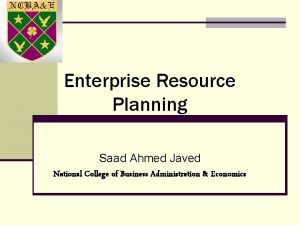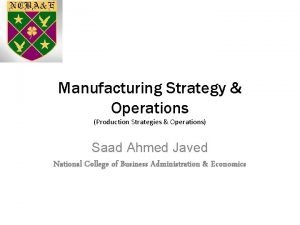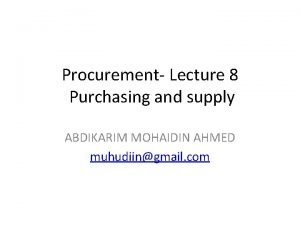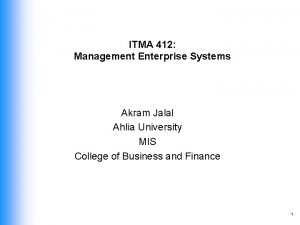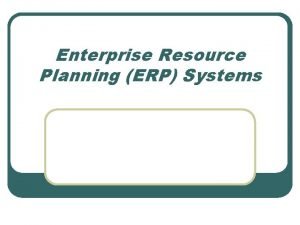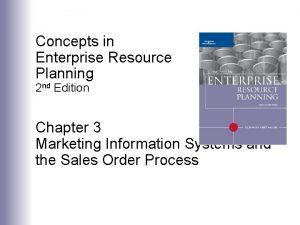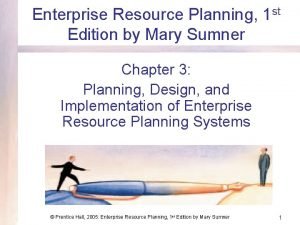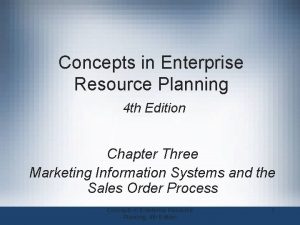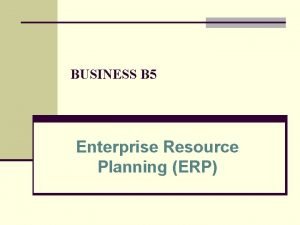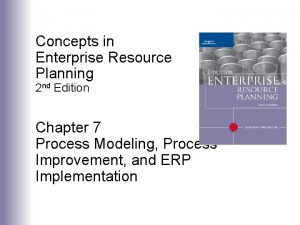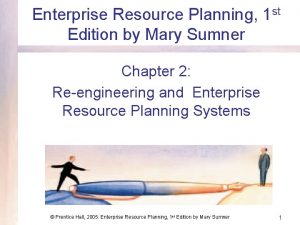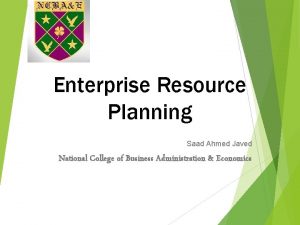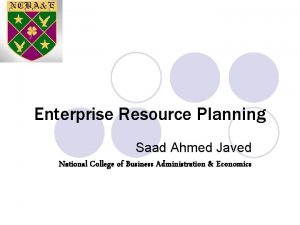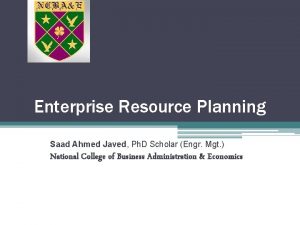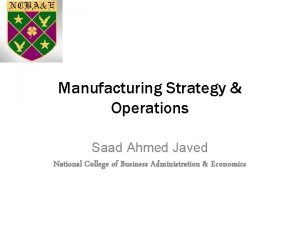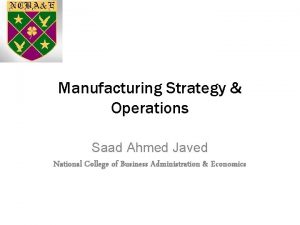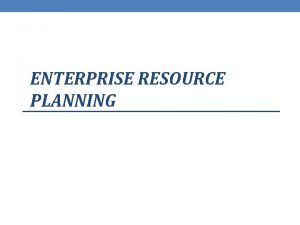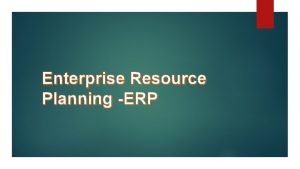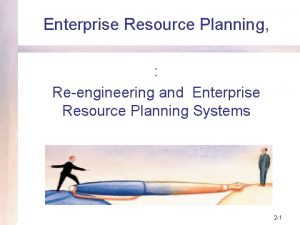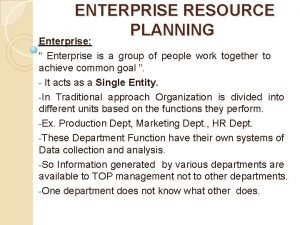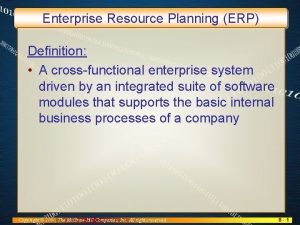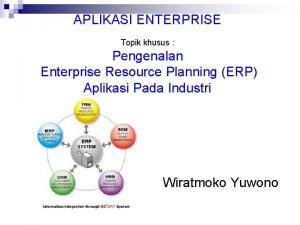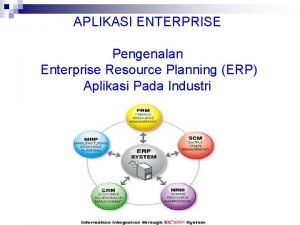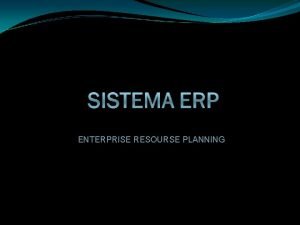ENTERPRISE RESOURCE PLANNING Saad Ahmed Javed Ph D































- Slides: 31

ENTERPRISE RESOURCE PLANNING Saad Ahmed Javed, Ph. D Scholar (Engr. Mgt. ) National College of Business Administration & Economics

ERP IMPLEMENTATION FAILURES ERP & BPR A Case of Hershey Foods Corporation, Inc. HP, Inc. Waste Management, Inc. Fox. Meyer, Inc.

HERSHEY FOODS CORPORATION ERP FAILURE 1999

“There is no doubt that 1999 was a most difficult and disappointing year for Hershey Foods Corporation. While the year got off to a slow start due to excessive retail inventories, we fully expected a strong finish in the second half of the year. Instead, the implementation of the final phase of the Corporation's enterprise-wide information system created problems in the areas of customers service, warehousing and order fulfillment. These difficulties were aggravated by our growth in recent years which had resulted in shipping capacity constraints. As a result, Hershey's sales and earnings fell well short of expectation for the year. ” - Kenneth L Wolfe (Chairman & CEO, Hershey Foods Corporation, in 1999)

COMPANY BACKGROUND • Chocolate Business started by Mr. Milton S. Hershey in 1876 • The Hershey Company was established in 1894 • One of the leading Chocolate manufacturer in North America (e. g. , Kit. Kat in USA*) • Hershey's sales are roughly 80% chocolate and 20% non-chocolate (cookies, milk etc) • Hershey’s Competitors include Mars, Nestle, Russell Stover, Palmer and Nabisco *Nestle produces Kit. Kat world over except USA

ERP IMPLEMENTATION • During late 1996, the management of Hershey gave its approval to a project named Enterprise 21 • For this Hershey selected SAP's R/3 ERP software, Manugistic's SCM software and Seibel's CRM software and IBM Global Service so as to manage integration among these three systems. • Overall Project Cost was US $10 Million (= PKR 1, 043, 600, 000 = +1 billion PKR!!!) • The recommended implementation time for the project was 4 yrs. and Hershey demanded for 2. 5 yrs. • Hershey decided to go with Big Bang Approach instead of phased approach

2 APPROACHES TO ERP IMPLEMENTATION • The phrases 'big bang' and 'phased' are used to describe ERP strategies for introducing new systems into an organization. • A 'big bang' ERP implementation is typically used to describe a go-live or cutover* scenario where a business switches from their old ERP system to their new system at a single point in time. • a ‘phased’ ERP approach describes a scenario where elements or modules of the ERP system are introduced in a planned sequence, replacing the old systems gradually. *Cutover: a rapid transition from one phase of a business enterprise or project to another.

IMPACT OF ERP FAILURE (1) • Problems pertaining to order fulfillment, processing and shipping started to arise; Hershey would not be able to meet its committed date of delivery • Several of Hershey's distributors who had ordered the products could not supply them to the retailers in time, and hence lost their credibility in the market • Product inventory started to pile up and by the end of September 2000; the inventories were 25% more than the inventories during the previous year

IMPACT OF ERP FAILURE (2) • After Hershey’s announcement in the market about problems due to malfunctioning of the newly installed computer systems, Hershey's stock price plunged by 8% on a single day. • Hershey's failure to implement the ERP software on time costed the company US $150 million in sales. Profits for the third quarter 1999 dropped by 19% and sales declined by l 2%, in its 1999 annual report.

REASONS OF FAILURE • Over-squeezing implementation schedules • Big Bang Approach instead of Phased Approach • Mistake of sacrificing systems testing for the sake of expediency • Cutover Activities and Go-Live was scheduled in Hershey’s busiest business periods

LEARNING FROM FAILURE • Do not force an ERP implementation project into an unreasonable timeline • Never schedule cutover during busy seasons • Testing phases are safety nets that should never be compromised

HP ERP FAILURE 2004

INTRODUCTION • August 2004, HP announced that their revenue for 3 rd quarter from its Enterprise Servers and Storage (ESS) department had gone down by 5% to $3 bn. • Reasons stated for the downfall was due to migrating to a centralized ERP in one NA* division. • Total financial impact of the failure was around $160 million. • This loss was more than 5 times the cost of implementing ERP. *NA: Network Automation - automates the complete operational lifecycle of network devices within an organization

BACKGROUND • HP is an American multinational corporation headquartered in Palo Alto, California, US. • Provides products, technologies, software, solutions and services to consumers including government, health and education sectors. • Stanford engineers Bill Hewlett and David Packard started HP in California in 1938 as an electronic instruments company. • First product was a resistance-capacity audio oscillator, an electronic instrument used to test sound equipment.

ERP IMPLEMENTATION • HP implemented my. SAP ERP. • HP started their migration of data with SAP into my. SAP ERP. • After two months, the result of the migration had decreased revenues. • SAP had already roll out the application 4 times and this roll out was number 5. • Gilles Bouchard became the CIO and Executive Vicepresident (EVP) of global operations at HP. He was made responsible for both the supply chain and ERP software implementations.

REASONS OF FAILURE • HP revealed that there was execution problem and there was no fault of SAP in it. • There were small technical glitches/ malfunctions but the main issue was contingency planning, which was not addressed properly. • The other issues were like: • Data Integration Issues • Demand Forecasting Problems • Poor planning & Improper Testing

IMPACT OF ERP FAILURE • The ESS division's order system became unstable due to problems with data integrity and a simultaneous increase in demand for HP's Standard Servers. • This technical glitch led to improper routing of orders and caused backlogs* to escalate till the end of August 2004. • Analysts commented that the Company’s culture did not support the much active involvement of employees also Co. ignored valuable suggestion from employees. • Many Vice-Presidents had joined the rival Co. and also many employees had a fear of been laid-off * Backlog: an accumulation over time of work waiting to be done or orders to be fulfilled

LEARNING’S FROM FAILURE • Implementation failure can impact overall business performance. • HP had spent huge amounts of money in speeding up delayed orders. • There has to be a detailed mapping between the departments and their business requirements or else it would miss the objectives. • The success of implementation depends upon the planning, which considers the business process along with the technical aspects.

WASTE MANAGEMENT ERP ISSUE - 2008

ABOUT : WASTE MANAGEMENT • Waste Management, Inc. is North America's leading provider of integrated environmental solutions • WM is leading developer, operator and owner of waste-to-energy and landfill gas-to-energy facilities in the United States • Mission : To maximize resource value, while minimizing environmental impact so that both our economy and our environment can thrive

ROUTE CAUSE • The project has to be completed in 10 Months (8 months for pilot program & 2 months for Implementation) but it took 2 Years to implement.

WM V/S SAP WM’S CLAIM SAP AG’S CLAIM • Wanted an ERP package that could meet its business requirements without large amounts of custom development within time period • SAP used a ‘fake’ product demonstration” and “SAP’s technical team had ‘recommended that SAP deliver to Waste Management a later version of the software than the version SAP in fact delivered’. ” They also claimed SAP knew the software was “unstable and lacking key functionality • It suffered significant damages, including more than $100 million it spent on the project, which it has dubbed "a complete and utter failure, " and more than $350 million for benefits it would have realized if the software had been successful. • Waste Management didn’t ‘timely and accurately define its business requirements’ nor provide ‘sufficient, knowledgeable, decisionempowered users and managers’ to work on the project. ” RESULT: WM and SAP settled the issue outside the court through a “confidential” agreement in which WM received "a one-time cash payment" from SAP. Process took almost 2 years.

FAILURE CAUSES • Lack of Senior management support. • However their support is not enough, what the Waste Management lawsuit points out is that risk management (risk identification and risk mitigation) are critical components of an SAP project. • In this case it seems entirely reasonable, and plausible, that Waste Management did not provide key, timely information or key decision-makers as SAP had said. However, it also found Waste Management's other claims they made in later pleadings that the SAP sales force had a strong hand in creating the problem because the sales person was concerned about getting their million dollar commission. • SAP paid compensation to WM but they advertised that responsibility of failure wasn’t SAP’s. A win-win solution!

LESSON LEARNED • Organization or company who implements SAP, ERP, or other enterprise software applications must ensure they are in control of their own project. • This would generally fall under numerous critical success factors: business process engineering, change management, scope management, senior management support, formal project plan and schedule, consultant experience, implementation strategy, and amount of custom coding. • Delivering a project with standard system functionality, and on time / on budget requires strong leadership from both the customer and the integrator.

FOXMEYER ERP FAILURE – 1993 -98 ERP & BPR

INTRODUCTION • Fox. Meyer Drugs was a $5 billion company. • United States’ fourth largest distributor of pharmaceuticals. • They thought of Implementing ERP for using technology to increase efficiency. • Fox. Meyer conducted market research and product evaluation and purchased SAP R/3 in December 1993. • Fox. Meyer also purchased warehouse-automation from a vendor called Pinnacle. • They chose Andersen Consulting to integrate and implement the two systems, and named the project as Delta III • Implementation of the Delta III project took place during 1994 and 1995.

TIMELINE 1993 • Project kick-off • Software acquisition • Fox. Meyer signed a large contract to supply equipment to University Health System Consortium (UHC). [They assumed project will cost them USD 40 m and will benefit them (USD 5 b) in 5 years] 1994 • 1995 1996 1998 Implementation • Thomas Anderson, Fox. Meyer Health's president and CEO (and champion of the company's integration /warehouse-automation projects) was asked to resign due to delays in the new warehouse and decline in the SAP system's projected savings. • Bankruptcy • The trustee of Fox. Meyer announced that he is suing SAP, the ERP vendor, as well as Andersen Consulting, its SAP integrator, for $500 million each

REASONS OF FAILURE • Although senior management commitment was high, reports reveal that some users were not as committed. • There was a morale problem among the warehouse employees, warehouse automation threatened their jobs • The execution of the project was an issue due to the shortage of skilled and knowledgeable personnel. • There were over 50 consultants at Fox. Meyer, many of them were inexperienced and turnover was high (Computergram International 1998).

REASONS OF FAILURE • Although Fox. Meyer must have realized the project was in trouble, its dependence on consultants and vendors prevented it from seeing how it could gain control. Since Fox. Meyer was competing on price, it needed a high volume of transactions to be profitable. However, volume of transactions decreased during the period. • The New SAP R/3 could process only 10, 000 customer orders per night, compared with 420, 000 under Fox. Meyer's original mainframe system

IMPACT OF FAILURE • Thomas Anderson, Fox. Meyer Health's president and CEO was asked to resign due to delays in the new warehouse and decline in the SAP system's projected savings. • Fox. Meyer was driven to bankruptcy in 1996, and the trustee of Fox. Meyer announced in 1998 that he is suing SAP, the ERP vendor, as well as Andersen Consulting, its SAP integrator, for $500 million each (Source: Caldwell 1998, Stein 1998).

 Saad ahmed economics
Saad ahmed economics Is an extended erp module
Is an extended erp module Saad ahmed javed
Saad ahmed javed Saad ahmed javed
Saad ahmed javed Ahmed muhudiin ahmed
Ahmed muhudiin ahmed Enterprise resource planning example
Enterprise resource planning example Erp meaning
Erp meaning Enterprise resourse planning systems
Enterprise resourse planning systems Concepts in enterprise resource planning
Concepts in enterprise resource planning Cayenta human capital management
Cayenta human capital management Sistema erp adalah
Sistema erp adalah Pengertian erp dan contohnya
Pengertian erp dan contohnya Enterprise resource planning mary sumner
Enterprise resource planning mary sumner Concepts in enterprise resource planning
Concepts in enterprise resource planning Core and extended erp components
Core and extended erp components Contemporary management theory ppt
Contemporary management theory ppt Concepts in enterprise resource planning
Concepts in enterprise resource planning Enterprise resource planning mary sumner
Enterprise resource planning mary sumner Sap lieferplan kopierer sd
Sap lieferplan kopierer sd Javed kalangade
Javed kalangade Javed kalangade
Javed kalangade Javed kalangade
Javed kalangade Mazhar javed awan
Mazhar javed awan Characteristics of patriarchy
Characteristics of patriarchy Klodia saad
Klodia saad Dr sadia saad
Dr sadia saad Ryan saad
Ryan saad Kussmaul sign
Kussmaul sign Saad bashir
Saad bashir Télégestion saad
Télégestion saad Joanne saad
Joanne saad Mohsen hassan
Mohsen hassan

